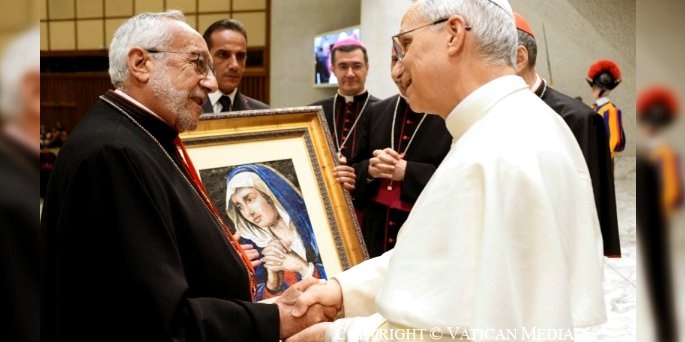SucheSuchen Sie im kath.net Archiv in über 70000 Artikeln: 



Top-15meist-diskutiert- Vatikan-Kommission: Frauen können nicht zur Diakonenweihe zugelassen werden
- US-Präsident Trump veröffentlichte erstaunliche Würdigung der Muttergottes
- Die Kirche in Deutschland und in der Schweiz hat kapituliert
- Republik der Dünnhäutigen
- Manuel Ostermann, Vize-Vorsitzender der Polizeigewerkschaft: „Die Kriminalität explodiert“
- Auch ohne Weiheamt für Frauen ist der Diakonat das Zukunftsthema für die Kirche
- Verhöhnung von Jesus und der Muttergottes - Schweigen von Schönborn, Grünwidl & Co.
- Katholischer Philosoph ausgeladen – ‚Erschießen werden wir ihn nicht ‘
- US-Bischof Daniel Thomas/Ohio: „Gott hat Transsexualität nicht vorgesehen“
- Niemand rettet die Welt allein. Nicht einmal Gott will sie allein retten
- Papst Leo: „Wer sagt, dass ich nicht gebetet habe? ... Vielleicht bete ich sogar jetzt“
- Forscher warnen vor früher Smartphone-Nutzung von Kindern
- 100.000 Euro von der EKD für Afghanen, damit diese Aufenthalt in Deutschland einklagen können
- Rome Reports: „Der Countdown für den Einzug von Papst Leo in den Apostolischen Palast läuft“
- Kardinal Woelki in Kurienbehörde für Heiligsprechungen berufen
| 
Synodality, Ecumenism, and Liturgy in the Pontificate of Pope Leo XIV11. Mai 2025 in English, keine Lesermeinung
Druckansicht | Artikel versenden | Tippfehler melden
“For Leo XIV, liturgy is not mere decoration or ritual, but the expression and enactment of ecclesial identity” – “Particularly impressive is the esteem Leo XIV shows for the Byzantine liturgy”. By Archimandrite Dr. Andreas-Abraham Thiermeyer
Vatican (kath.net) Spirituality as a Structural Principle
I. Introduction: The Church Between Structure and Spirit
In a time of global ecclesial upheaval and theological polarization, the pontificate of Pope Leo XIV has emerged as a spiritual compass. At the heart of his pastoral and theological mission lies the reclaiming of the Church as a spiritually structured communio. In doing so, he unites two dimensions of ecclesial life often considered separately: synodality as a spiritual mode of ecclesial decision-making, and liturgy as the source and summit of the Church's life (Sacrosanctum Concilium 10). Together, these form the foundation of his ecclesiological vision – a Church sustained not by strategies but by listening to the Spirit.
II. Synodality as a Spiritual Practice: More Than a Church-Political Tool
1. The Theological Depth of Synodal Action
Under Leo XIV, synodality is not interpreted in a functionalist way – as a tool for participation or democratization – but is grounded pneumatologically. The key phrase is auditus fidei: synodality is the communal act of listening to what the Spirit is saying to the Churches (cf. Rev 2:7). This represents a decisive shift in perspective: not primarily processes or structures are emphasized, but the spiritual attitude of discernment within the community.
2. Synodality and the Conversion of Judgment
Pope Leo XIV repeatedly emphasizes the need for an “asceticism of listening” – an attitude that does not aim at asserting personal positions, but at discerning God’s will together. Synodality thus becomes a school of conversion: it requires a “conversion of judgment,” as described by Ignatius of Loyola in the Spiritual Exercises. Only those willing to be challenged by others and by the Spirit can truly participate in a synodal process.
3. Ministry as a Service of Mediation – Not Domination
In the Synods of 2023 and 2024, Leo XIV saw his role less as a figure of command and more as a spiritual moderator. For him, the Petrine ministry is not a centralist governing tool, but a place of spiritual discernment. He acts as a mediator among cultures, theological perspectives, and spiritual traditions – and in doing so, he gains authority through humility.
III. Liturgy as the Theological Anchor of Ecclesial Identity
1. Liturgy as the Church’s Sung Faith
For Leo XIV, liturgy is not mere decoration or ritual, but the expression and enactment of ecclesial identity. The Eucharist stands at the center – not merely as a memorial, but as presence and source of missionary sending. Following Augustine, he describes the liturgy as sacramentum unitatis – a visible sign of inner unity, which is not ideologically uniform, but spiritually convergent in its polyphony.
2. Song as a Spiritual Act of Incarnation
Particularly noteworthy is the theological importance Leo XIV places on singing. His intoned “Kyrie,” “Gloria,” “Pater noster,” or “Regina caeli” are not acoustic embellishments but bodily expressions of spiritual devotion. In the Augustinian phrase cantare amantis est – “The one who loves sings” – singing becomes an expression of the heart and an incarnation of faith.
3. Liturgy as a School of Synodal Participation
In Leo XIV’s view, liturgical participation is not about the functional distribution of roles but about spiritual inclusion in the mystery. Liturgy is where ecclesial participation becomes tangible – not merely through assigned roles, but through shared celebration of Christ. Thus, liturgy gains a synodal dimension: it becomes lived communio, not mere ritual.
IV. Synodality and Liturgy: Two Expressions of a Spiritual Option
In the interplay of synodality and liturgy, the spiritual profile of Leo XIV’s pontificate finds its depth. Synodality gives the Church structure – but not in an institutional sense, rather in the mode of spiritual discernment. Liturgy gives the Church direction – not through moralism or pedagogy, but through the experience of God and the call to mission. Together, they revitalize a Church that does not exist for itself but lives as a sacrament of salvation for the world (Lumen Gentium 1).
V. Ecumenism as a Spiritual Dimension: The Eastern Church as Sister and Teacher
1. Synodality as a Bridge for Ecumenism
Pope Leo XIV understands synodality not merely as an intra-Catholic structural principle, but as a theological category with deep ecumenical significance. Especially in dialogue with the Orthodox Churches, he sees a spiritual resonance that goes far beyond ecclesial diplomacy. The synodal structure of the Eastern Churches – with their deeply rooted traditions of conciliarity, spiritual discernment, and liturgical theocentrism – is not seen as a countermodel but as a fraternal complement to the Latin tradition.
2. The Eastern Liturgy as a Source of Western Renewal
Particularly impressive is the esteem Leo XIV shows for the Byzantine liturgy. In its expressive rites, the profound unity of word and icon, sound and prayer, he does not see a foreign form but a spiritual source that can offer guidance to the Roman Church as well. For him, Eastern liturgies are not exotic but exemplary: places where the presence of the Ineffable becomes tangible – not through rationality, but through mystery and beauty.
3. Spiritual Friendship Instead of Diplomatic Rhetoric
Leo XIV’s ecumenical approach is not shaped by interconfessional diplomacy, but by spiritual friendship. His encounters with patriarchs, monastic communities, and theologians of the Eastern Churches are marked by mutual respect – not in the sense of rhetorical unity, but as expressions of a shared search for the one Lord.
4. Synodality as a Possible Key to Unity
From Leo XIV’s perspective, synodality is not just a model for internal Church reform, but a possible key to future ecclesial unity – not through uniformity, but through synodal polyphony. The Eastern Churches, in their conciliarity, have preserved a living witness that unity does not require sameness. The West brings the element of universality and the Petrine office as an expression of unity in diversity.
VI. Conclusion: The Church as a Space for Listening, Celebration, Mission, and Reconciliation
In light of this ecumenical depth, the interplay of synodality and liturgy in the pontificate of Pope Leo XIV takes on an even broader dimension. The Church becomes visible as a space of spiritual processes – not an institution that defends itself, but a sacrament of unity in a fractured world. This unity is not the result of human consensus, but the fruit of the Spirit.
A Church that listens synodally and celebrates liturgically will also be capable of ecumenical reconciliation. In a time when many lament the loss of unity, Leo XIV offers a spiritual path: quiet, mystagogical, obedient to the Spirit. In this lies the hope for a Church that does not divide, but unites – not through power, but through love. 
Ihnen hat der Artikel gefallen? Bitte helfen Sie kath.net und spenden Sie jetzt via Überweisung oder Kreditkarte/Paypal!

LesermeinungenUm selbst Kommentare verfassen zu können müssen Sie sich bitte einloggen. Für die Kommentiermöglichkeit von kath.net-Artikeln müssen Sie sich bei kathLogin registrieren. Die Kommentare werden von Moderatoren stichprobenartig überprüft und freigeschaltet. Ein Anrecht auf Freischaltung besteht nicht. Ein Kommentar ist auf 1000 Zeichen beschränkt. Die Kommentare geben nicht notwendigerweise die Meinung der Redaktion wieder.
kath.net verweist in dem Zusammenhang auch an das Schreiben von Papst Benedikt zum 45. Welttag der Sozialen Kommunikationsmittel und lädt die Kommentatoren dazu ein, sich daran zu orientieren: "Das Evangelium durch die neuen Medien mitzuteilen bedeutet nicht nur, ausgesprochen religiöse Inhalte auf die Plattformen der verschiedenen Medien zu setzen, sondern auch im eigenen digitalen Profil und Kommunikationsstil konsequent Zeugnis abzulegen hinsichtlich Entscheidungen, Präferenzen und Urteilen, die zutiefst mit dem Evangelium übereinstimmen, auch wenn nicht explizit davon gesprochen wird." (www.kath.net)
kath.net behält sich vor, Kommentare, welche strafrechtliche Normen verletzen, den guten Sitten widersprechen oder sonst dem Ansehen des Mediums zuwiderlaufen, zu entfernen. Die Benutzer können diesfalls keine Ansprüche stellen. Aus Zeitgründen kann über die Moderation von User-Kommentaren keine Korrespondenz geführt werden. Weiters behält sich kath.net vor, strafrechtlich relevante Tatbestände zur Anzeige zu bringen. | 
Mehr zu | 





Top-15meist-gelesen- Vatikan-Kommission: Frauen können nicht zur Diakonenweihe zugelassen werden
- Die Kirche in Deutschland und in der Schweiz hat kapituliert
- US-Präsident Trump veröffentlichte erstaunliche Würdigung der Muttergottes
- Weihnachtsspende für kath.net - Wir brauchen JETZT Ihre HILFE!
- Papst Leo: „Wer sagt, dass ich nicht gebetet habe? ... Vielleicht bete ich sogar jetzt“
- Republik der Dünnhäutigen
- Mailands Erzbischof: Kollaps der Gesellschaft droht
- Beweise mir das Gegenteil!
- Auch ohne Weiheamt für Frauen ist der Diakonat das Zukunftsthema für die Kirche
- Legenden vom Heiligen Nikolaus
- Manuel Ostermann, Vize-Vorsitzender der Polizeigewerkschaft: „Die Kriminalität explodiert“
- Katholischer Philosoph ausgeladen – ‚Erschießen werden wir ihn nicht ‘
- Drei Kardinäle feiern 25 Jahre Erzbischöfliches Missionarisches Priesterseminar Redemptoris Mater
- "Wenn ihr dies lest, bin ich endlich in die Arme Jesu geschlüpft"
- EINLADUNG zur großen kath.net-Novene zur Muttergottes von Guadalupe - 4. bis 12. Dezember 2025
|






























